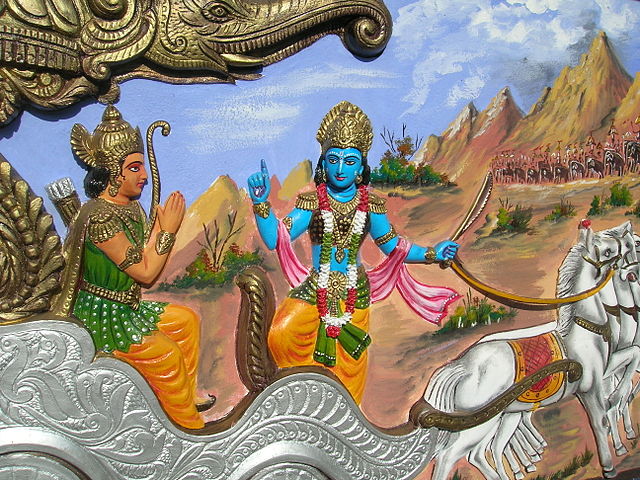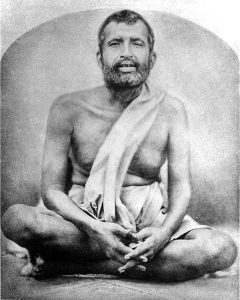Bhakti’s roles in spiritual life

Source: commons.wikimedia.com
In science, we have learned that light is present in two states – as a wave and as a particle. When photoelectric cells are present, light acts as a particle, whereas it acts as a wave when it falls on a mirror or some other reflective surface. Likewise, Bhagavan too is present in two states – nirguna (formless aspect) and saguna(one with form). These two aspects are like two sides of a coin. They are ultimately the same. The difference lies only in the approach.
Sri Ramakrishna Paramahamsa would often cite the following example to explain saguna and nirguna. Humidity (water droplets in the air) is everywhere. But, is that water of any use to us? Can we drink it? Only when it is condensed and turned into water, can one drink it. Similarly, Bhagavan as nirguna brahmam is everywhere. Yet, ordinary people like us cannot easily approach Him in that form. Only with bhakti, He becomes easily approachable.
Bhagavan is not only approachable, he also takes the responsibility for the devotee. Bhagavan is like a loving father. A father of a grown up son will not impose his ideas. He will let the son explore on his own and wait for the son to ask for help. Bhagavan too waits for us to call out to him. When we seek His help, then just as the father would happily give all the wealth he has accrued to his son, so too Bhagavan is ready to bestow his wealth – Jnana and Ananda to us.
Among Bhagavan’s innumerable qualities, kshama (tolerance/patience), karunA(compassion) and prema (love) are the ones that makes Bhagavan approachable. Bhagavan has so much compassion and love for all his devotees. When this compassion and love of Bhagavan blooms in our heart, it is Bhakti. That is why, Bhakti can never be earned nor can it sprout on its own. It can be attained only by the Grace of Bhagavan. In fact, Bhakti is not ours in the first place. It is Bhagavan’s. Only when He bestows it, Bhakti will flower in our hearts.
Therefore, in Bhagavad Gita, when Bhagavan says to Arjuna,
[“nAham vedai: na tapasA na dAnena na chejyayA
shakya evam-vidho drashTum drshTavAn asi mAm yathA”
Neither studying the Vedas, nor severe penance, nor charity nor by doing yagas can give one the ability to see me in the form that you are seeing.]
What Bhagavan is trying to convey is that, when all these paths are devoid of Bhakti, then it is difficult to attain Him. Bhakti is the foundation for all paths.
In fact, even to tread the path of Dharma and to be inspired to lead a spiritual life, one needs Bhakti. Bhakti transforms and inspires one to lead a life of Dharma. This is seen in Ajamila’s life. When Ajamila was on his deathbed, he called out to his son, “Narayana”. His son ignored the call, but the One who is the Lord of this Universe answered it and sent his parshadas (messengers). Their satsang not only saved Ajamila from the jaws of death but also transformed Ajamila. He turned his life around, chanted Nama for the next several months and eventually attained liberation.
Another thing to note is that bhakti and the various spiritual paths are not mutually exclusive. Bhakti complements any spiritual discipline. It can even go one step further and compensate for any shortcomings that may have occurred when practicing the spiritual discipline. This is shown in the Bali charitra in Bhagavatham. In the end, after Bali surrendered himself and Bhagavan blessed him, Bhagavan asked Sri Shukracharya to complete the Yagnya. Shukracharya completes it with the Divine Names of Bhagavan.
mantratas tantratas chidram desha-kAlArha-vastuta:
sarvam karoti nishchidram anusankIrtanam tava
If there are any gaps in the spiritual practice, when one does it with Bhakti, then Bhagavan takes the responsibility and ensures the gaps are filled.
Further, Bhakti by itself can be practiced as a sadhana. Jada Bharatha, practiced Bhakti as a sadhana and eventually attained Jnana.
Bhakti is also saadhya (the final goal which is to be attained). In Bhagavatham, we see that Parikshith heard Bhagavan’s katha and attained Bhakti. When he first came to the banks of Ganges, he had no clue what spiritual practice to follow. But, on the fourth day, he became restless for Krishna Katha. Parikshith was blessed with Bhakti. Bhakti is not just the means. It is the end as well.
And, finally, Bhakti is the fruit of Jnana. After attaining Jnana, Jnanis revel in Bhakti. Sri Shuka was a great Jnani, who was beyond the sense of duality. Yet, Bhagavatham shows us that even after attaining Jnana, he relished Krishna Bhakti.
Thus, Bhakti is key to progress spiritually. Right from inspiring one to live a dharmic life to compensating any shortcomings in spiritual practice, and to itself being a sadhana and the saadhya (final goal), Bhakti plays a crucial role in all phases of one’s spiritual journey. In fact, Bhakti is enjoyed even after attaining the final goal of Jnana. Therefore, let us pray to Bhagavan to bestow us with Bhakti that is the means, the end and beyond.
Sowmya Balasubramaniam, Dublin CA
Excerpted from on Bhagavad Gita Bhakti Yoga talks by Sri Ramanujamji, disciple of HH Maharanyam Sri Sri Muralidhara Swamiji
Click here to go back to the March 2023 newsletter page:
https://godivinity.org/newsletters/nama-dwaar-newsletter-march-2023/






